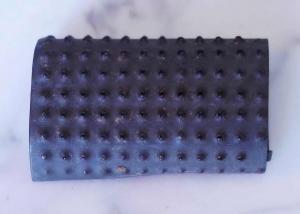Object: Spice Grater, 1790-1850
Described by one historian as the “quintessential spice”, nutmeg is the kernel of the apricot-like fruit of the tree Myristica fragrans and the soft membranous coat that covers its hard seed case is the spice, mace. These two spices were imported from the Spice Islands with clove. The desire of clove, mace, and nutmeg drove exploration to the original source of these spices which were islands on the Moluccan Sea. In a book written in 1880 called Medicinal Plants; being descriptions with original figures of the principal plants employed in medicine and an account of the characters, properties, and uses of their parts and products of medicinal value by Robert Bentley and Henry Trimen, nutmeg is mentioned as being “used with advantage in mild cases of diarrhea, flatulent colic, and certain forms of dyspepsia…” Spices such as nutmeg were used in food and nutmeg graters were produced beginning in the late 17th century with the growing popularity of serving punch: a brew of rum or brandy, fruit juice, sugar, and water laced with nutmeg and sugar.
 |
| Nutmeg Grater, Case and Cover Acc#: 1968-72, A-B 1708-1708; Maker: Alexander Hudson DeWitt Wallace Decorative Arts Museum |
Graters were made of all shapes and sizes, some made suitable for carrying in the pocket and also fitted in a box to hold the nutmeg once grated. The availability of small graters, like this one, “eased [the] preparation” of punch. By the end of the seventeenth century one historian points out that “for fashionable Britons on both sides of the Atlantic, the drinking of warm beverages (coffee, tea, and chocolate), the adopting of polite dining practices in the French mode, and the serving of punch became highly organized social rituals”. The Randolphs would have kept up with these latest fashions and were served beverage cold this time of the year to combat the summer heat.
Punch, as one historian asserts, “became the most popular mixed alcoholic drink of the 18th century.” This same historian discovered that William Byrd II of Westover Plantation wrote in his Natural History of Virginia, published in 1737, about the process of making punch. Byrd attests that “after which one has a very pleasant drink” and also recorded in his diary, November 16, 1737, while in London about being given a nutmeg grater as a gift. A member of the Randolph family would have been able to afford a fancier nutmeg grater than this one, possible made of silver (see above image) that fitted in a cylindrical box but that served the same purpose.
Bibliography
Davis,
John D. The Robert and Meredith Green Collection of Silver Nutmeg Graters.
Googlebooks.com. 23 May 2013. <http://books.google.com/books?id=tD6zzh7Xfv4C&pg=PA8&source=gbs_toc_r&cad=4#v=onepage&q&f=false
Earle,
Alice Morse. Home Life in Colonial Days. GoogleBooks.com. 23 May
2013.
<http://books.google.com/books?id=B2RWAAAAMAAJ&pg=PA158&lpg=PA158&dq=Colonial+Spice+Grater&source=bl&ots=qfcCMSquUA&sig=13WkMrpMsUdvwUDRA3x6ut5Nels&hl=en&sa=X&ei=NxfDUZLOM_ay4AO5yIGwDg&ved=0CFgQ6AEwCDgK#v=onepage&q=the%20table%20at%20meal-times%2C%20and%20the%20tiny%20ornamental%20graters%20which%20were%20carried%20in%20the%20pocket.&f=false>
“Nutmeg and Mace”. UCLA: History and
Special Collections, Louise M. Darling Biomedical
Library. 18 May 2013. <http://unitproj.library.ucla.edu/biomed/spice/index.cfm?displayID=19>
“Spices in Early America: A
Bicentennial Report”. Times Daily. 10
December 1974. Google
news. 18 May 2013.
<http://news.google.com/newspapers?nid=1842&dat=19741210&id=6v4rAAAAIBAJ&sjid=pccEAAAAIBAJ&pg=730,2825345>
“Nutmeg Graters”. ASCAS. 18
May 2013. <http://www.ascasonline.org/articolo11.html>.
Image
Credit
http://emuseum.history.org/view/objects/asitem/search@/2/title-asc?t:state:flow=2118ed2f-282f-43d5-ba58-bdacffcc3ce0


No comments:
Post a Comment